Japanese style in the interior
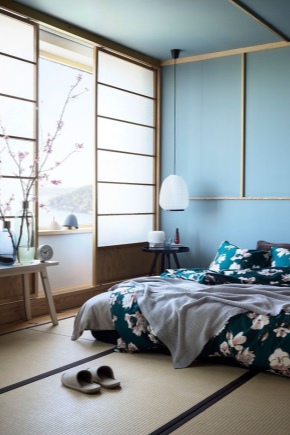
Japan is one of the few countries with a distinctive and alluring culture that the whole world is trying to follow. Although in recent years Japanese culture is mostly known for anime, in fact, you can join it through the appropriate interior decoration of your own home.
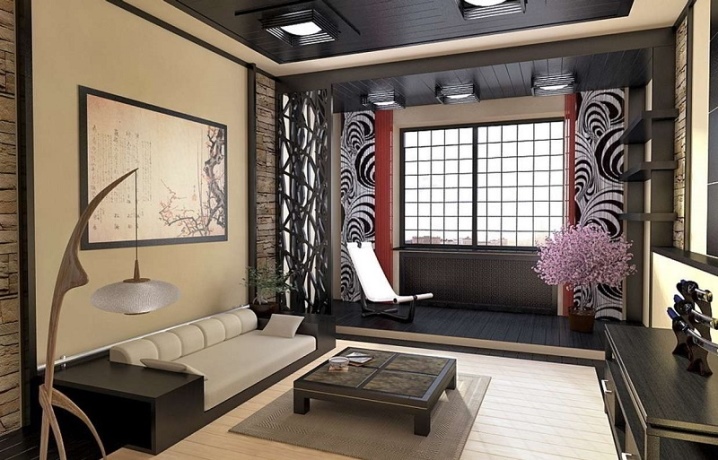
Peculiarities
The Japanese style of home decoration should not be considered something that has been finally established and cannot be changed - for all its originality distinguish at least the classic approach to interior design and the more modern, characteristic of today's Japan. The differences are understandable - the classics require the rejection of modern materials and high-tech in all its manifestations, while modernity, on the contrary, does not pursue the goal of disguising itself as antiques at all. However, both directions of the same style have much more in common than differences, so let's go through the characteristic features of the Japanese interior.

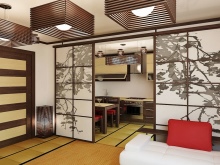
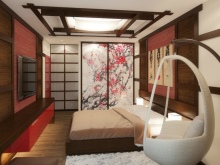
- More space. The Japanese are not the kind of people who consider it right to force every free millimeter with furniture. On the contrary, they focus on practicality, and if there is free space in the room, so be it, it does not need to be clogged just with something. In the same way, they reason about the abundance of jewelry - a large number of details only overload the energy of the house, and this is bad.
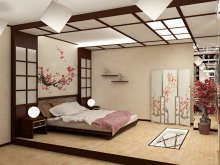
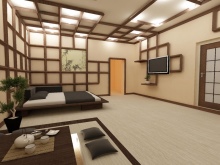
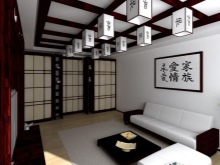
- Emphasis on functionality. In a Japanese house, no matter how large it is, there should be enough free space so as not to put pressure on the psyche. With this approach, in many homes, it is literally necessary to select furniture so that it performs as many functions as possible. In the modern direction, the use of various transformers is not even the norm, but a pattern.
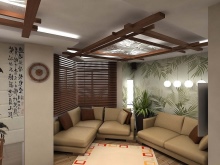
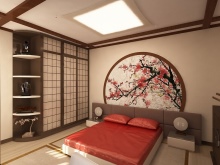
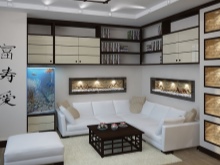
- Environmental friendliness. Even in our time, the Japanese have not lost their craving for natural materials, and in the old days they did not have a particularly developed industry and trade with other countries in order to actively purchase the same metals or glass. Therefore, the classic Japanese interior actively presses on semi-handicrafts. In the modern format, the Japanese often give preference to hi-tech, but it is faceless, not tied to a specific country, and those who want to pay tribute to centuries-old traditions simply choose artificial imitations of natural materials.
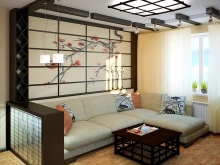
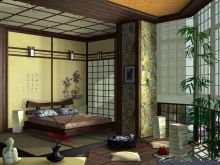

- Change of room functions. Everyone knows about the problem of overpopulation in Japan, and this problem did not arise yesterday. For this people, it is customary and characteristic to live in very small-sized housing, where there is simply no way to single out separate functional rooms. The problem is solved simply: during the day, the room should be a living room, and at night - a bedroom.
To do this, of course, you need to choose the environment accordingly.
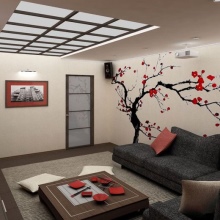
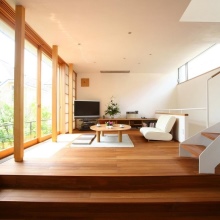
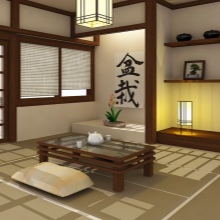
Finishes and colors
The stretch ceiling is quite consistent with the idea of the classic Japanese style, but at the same time it must be matte - there was no place for gloss in the style of the Land of the Rising Sun. In this case, the surface should be monochromatic. If for some reason an alternative is needed, you can use the same matte glass plates. - they can and should have backlighting, but strictly moderate.
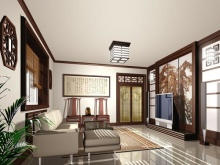
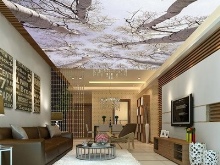
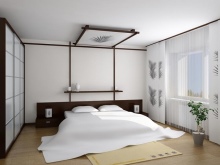
Partitions in the form of white rice paper on a wooden frame are well recognized around the world thanks to films about samurai, but in the conditions of an apartment, of course, few people will abandon full-fledged walls in favor of such a solution. This is not necessary - you can find wallpapers on sale that look quite natural. Alternatively, the Japanese also often draped the walls with fabrics, but not heavy, as was customary in European classicism, but airy, necessarily natural.
Their color is selected so as to blend in with the floor.
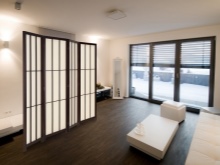
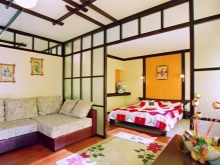

According to all the rules of the Japanese style, the floor is decorated with natural wood of light shades., but many of our compatriots strive to convey only the atmosphere instead of a completely exact copy. A more budget solution would be bamboo laminate, and from a visual point of view, it will not be any worse.
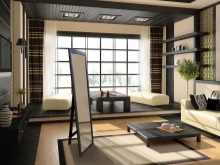


Choosing furniture
Japanese culture is so different from European that even furniture here has a number of characteristic properties that are not very familiar to our understanding of furniture. This can be described in a few simple theses:
- all lines and contours are straight - no inappropriate curls, waves, bends;
- decor on the surface of functional furniture is not needed - it does not decorate the house, but performs clearly defined functions;
- high furnishings are not encouraged - the Japanese, who are naturally short, chose furniture for their height.

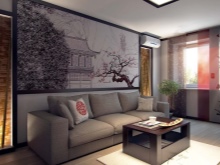
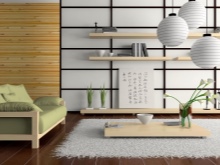
A great advantage of the Japanese style for modern connoisseurs of beauty is that it is largely ascetic, which means that it allows you to significantly save on purchasing the same furniture. In fact, you can add a touch of Japanese flavor without radically replacing all the furniture, only by adding such characteristic accents as the traditional Japanese sliding wardrobe with window doors and a special low table for holding famous tea ceremonies.
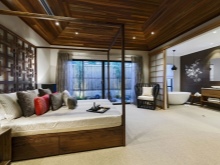
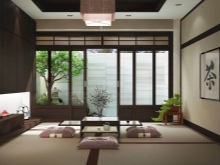
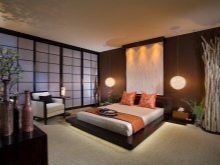
The most bulky items will have to be abandoned - giant wardrobes and dressers, large-scale dressing tables, pot-bellied armchairs do not fit the Far Eastern style. If we are talking about bedside furniture, then there are only two requirements for it - modest size and simplicity of design without frills. The problem of the lack of spacious wardrobes is solved both by drawers hidden in the depths of the bed or right in the wall, and by specific Japanese chests, which will have to be specially ordered, because we simply do not have them on sale.
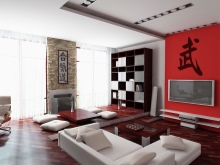
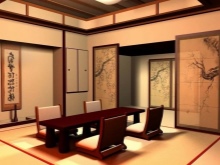
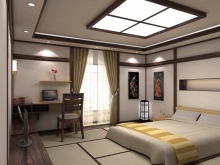
Upholstered furniture is upholstered only with natural materials - from cotton to leather. When choosing upholstery, one cannot ignore such material characteristics as strength - practical samurai believe that all things should serve for a long time and reliably.
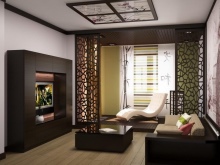
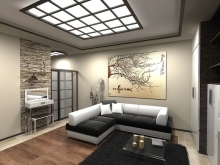

There are also a number of things, many of which can only be called furniture with a certain reservation. Their presence in the room will definitely enhance the feeling of being directly in Japan. First of all, these are tatami - characteristic reed mats, as well as cotton futon mattresses. The famous Japanese screen made of rice paper on a wooden frame is called "byobu" - even its imitation will immediately direct the guest's thoughts in the right direction. Finally, the so-called tansu, a special chest of drawers with pull-out drawers, will complement the flavor.
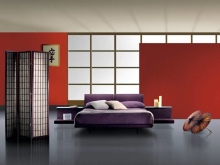
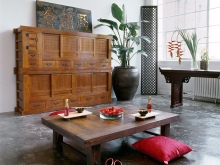

Textiles and accessories
At first glance, the Japanese do not strongly favor textiles, preferring rice paper, but in fact, of course, there are a lot of fabrics in the interior, they just do not catch the eye, since they do not stand out in color, but, on the contrary, are matched to the overall calm range of the room. As in all other cases, the emphasis is on materials of natural origin - usually cotton and linen, and in more expensive interiors, silk. Not only bright colors are not welcome, but also patterns, although textiles can be painted with characteristic oriental patterns or hieroglyphs.
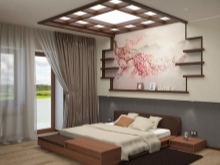
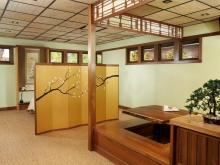
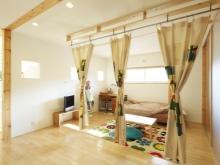
The main place of use of textiles is predictably - this is the sleeping area, but fabrics can be found in other places as well. Rice paper partitions can also be woven; division into rooms is sometimes performed with light screens that can be quickly removed by urgently reformatting the dwelling.

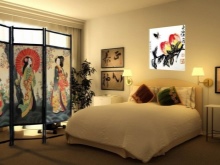

The windows are closed with a product that is called "Japanese curtains", and they, by the way, in the last decade have already spread widely in our country. This is not at all a fluttering curtain in the classical sense of the word, but something like huge vertical blinds with large pieces of fabric securely fixed in a certain position.

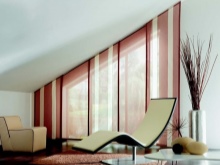

As with the rest of the textile parts, the Japanese prefer monochromatic curtains, but today models are gaining popularity in the world, somewhat violating the classical aesthetics, but adding a touch of color thanks to the typical oriental print. Instead of such curtains, modern designers still use roller blinds or fabric blinds.

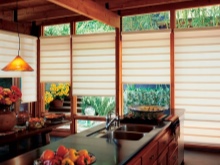

It is very important not to overdo it with decor, but it would be wrong to think that the Japanese style does not accept it at all. - there just shouldn't be too much, the point is not in it. In many cases, quite practical objects are used as decor, which simply look very unusual in our realities - these are the same partitions, and caskets, and floor vases, and beautifully laid out traditional fans, and samurai daggers.
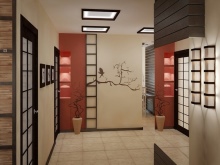
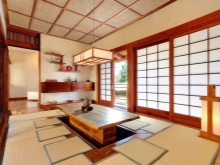
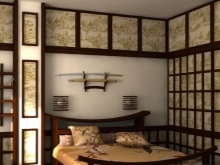
Nature should find a place in the Japanese interior, therefore ikebana and bonsai are welcome, and a sprig of cherry blossoms in a vase is a thousand times dearer to any Japanese than all other flowers in the world. You can decorate any object with a hieroglyph applied to it, just choose with meaning, because your guests can theoretically understand Japanese.
"Branded" Japanese netsuke figures may well complement the interior.
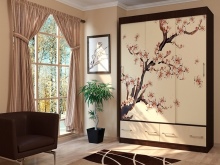


Lighting options
Practical Japanese people may give up on overly artistic ornaments, but they see no point in sitting in the dark. Moreover, the lighting system is usually chosen multi-level - thanks to this, the amount and brightness of light can be accurately dosed, focusing on the time of day outside the window. The Japanese style of interior decoration prefers diffused light, which is not directed to any one point, therefore lampshades are necessary. At the same time, they can emphasize ethnic aesthetics if they are made from imitation of rice paper or bamboo, or even better - the same materials in the original. At the same time, it is not worth painting them - it is optimal if they retain their natural appearance, or at least they will not be a bright spot against the background of a calm and pacifying interior.
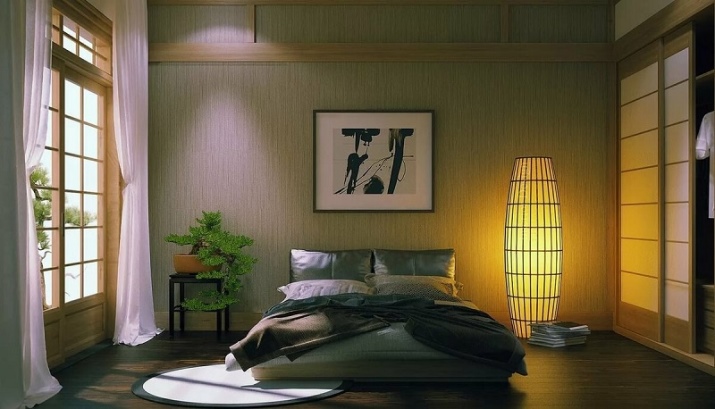
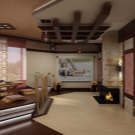
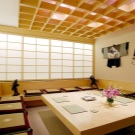
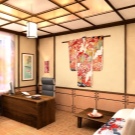
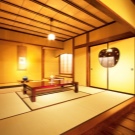
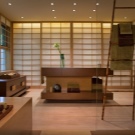
Without focusing on directional light, the inhabitants of the house will probably sometimes want to illuminate part of the room brighter, leaving the rest of the space in the twilight. This is possible thanks to the use of sconces, which not only give light where it is needed, but also change the perception of the room. As mentioned above, the same room can perform completely different functions depending on the time of day, so such a trick is very appropriate.
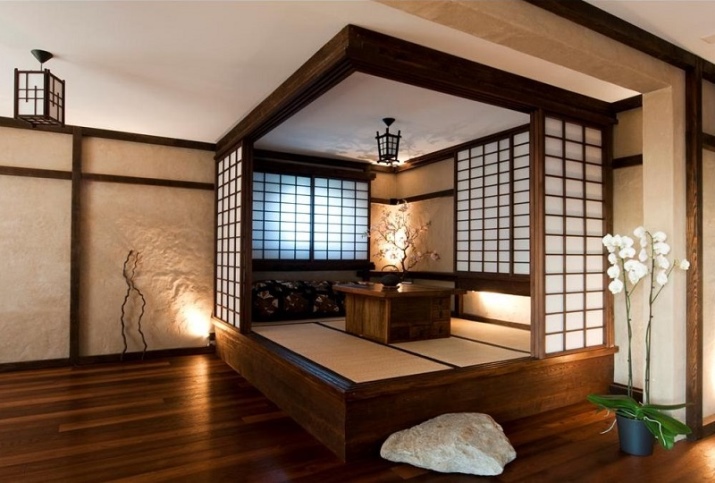

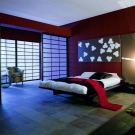
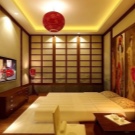
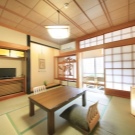
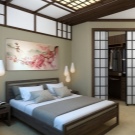
How to decorate a room?
In view of the specifics of the style, a studio apartment is best suited for Japanese decoration, in which there are almost no interior walls - this gives space for the installation of interior partitions and sliding doors. Due to the active use of the transformable space, even a small apartment can be decorated both stylishly and practically. But for a large house, this solution may not be suitable, if only because the Japanese style does not like decor and excesses - the building will simply be empty.
If other popular styles often require creative design vein, then a project of a room in Japanese design can be built with your own hands, since, in fact, this is a constructor that does not particularly allow you to take steps to the side, clearly prescribing most of the aspects. The drawings here are rather arbitrary - they show the position of the wooden partitions in one position or another, and specify the position of the counted pieces of furniture.
The recipe is up to you - you do not add anything, and even replacing individual ingredients with others is undesirable - strictly follow the instructions.

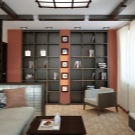
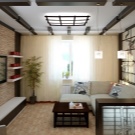
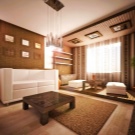

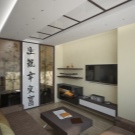
Children's
Children rarely find true satisfaction in asceticism, because the classic Japanese style is not quite for them - they can be bored in such a room. Designers usually find a solution to the problem in some kind of violation of stylistic prescriptions.
Deviations from the norm concern, first of all, an increased dosage of decor, but then, of course, it should have a direct link to the oriental flavor. For a girl, for example, contemplation of flowers will be pleasant, therefore you can paint the wall or hang it with a cloth with blooming sakura printed on it. For a teenager interested in culture and history, katanas are a great souvenir.
Regardless of the gender of the child, it is no longer necessary to adhere so strictly to the black and white design typical for Japan with minor inclusions of other shades - more liberties should be allowed. The same big red circle on a white wall can be a decorative element without disturbing the atmosphere, because this is the flag of Japan.
In the same way, you can and should experiment with curtains, which can be decorated with colorful prints in the nursery.


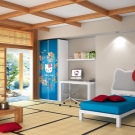

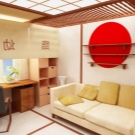
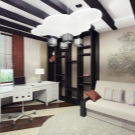
Bedroom
The decoration of the bedroom should be strictly natural - wood, typically oriental bamboo and rice paper, only natural fabrics. The general range is usually chosen light and rather soft, and only the floor can be made contrasting, noticeably darker. The backlight is hidden in the false ceiling, but the emphasis is not on it, but on natural lighting, which should not be so small.
The Japanese bedroom does not recognize a large amount of furniture, especially since bulky wardrobes are inappropriate in it, therefore it is worth getting wardrobes built into the walls. Alternatively, only a chest of drawers can be used, but in no case should it be too large.
With strict adherence to traditions, it is better to do without a bed altogether, using a mattress laid on the podium.

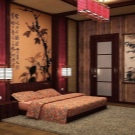
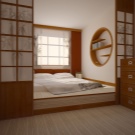
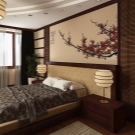
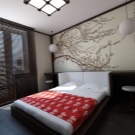

Living room
A typical European living room is always a kind of exhibition hall, and when it is decorated in the Japanese style, you will definitely not lack originality, because the room will come out surprisingly ascetic. Contrary to the skepticism of many of our fellow citizens, this approach is very much appreciated in the sense that it is an outlet, an uncommon solution that attracts attention and is remembered.
The simplicity of the living room design is good in that the absence of an intrusive decor pushes you to full-fledged communication. It is also convenient to clear your thoughts of all strangers here, because there are no unnecessary associations, and you can just relax. A sofa, a low table for tea drinking with seating cushions scattered right on the floor, a couple of vases or figurines in special niches - that's all you need.
In our reality, a relaxation is allowed, caused by the fact that we do not really like to sit on the floor for a long time - the seats may not correspond to Japanese traditions, if it is more convenient for you.


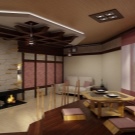
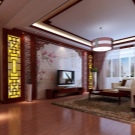
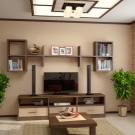

Interior design examples
The first photo clearly shows what a living room might look like. In fact, there are so few things, along with jewelry, that you can almost count them on your fingers, but there is absolutely no feeling that something is missing. Such minimalism is even pleasant, and the atmosphere of Japan is inspired by details - a characteristic low table, a "square" window, a vase, patterns on the wall.

The bedroom is even more minimalistic, because here you do not accept anyone and do not do any business, but on the contrary, you are distracted from the hustle and bustle. The bed, as it should be, is very low, you cannot see the cabinets in the frame.The naturalness of the interior is emphasized by the bamboo wall decoration, but in general there is quite a lot of purely Japanese decor - the hieroglyph on the ceiling made of glass panels, fans, and bonsai. At the same time, the gamut remains very restrained, and only greens are knocked out of the general gray-brown palette, but it is natural and quite appropriate.
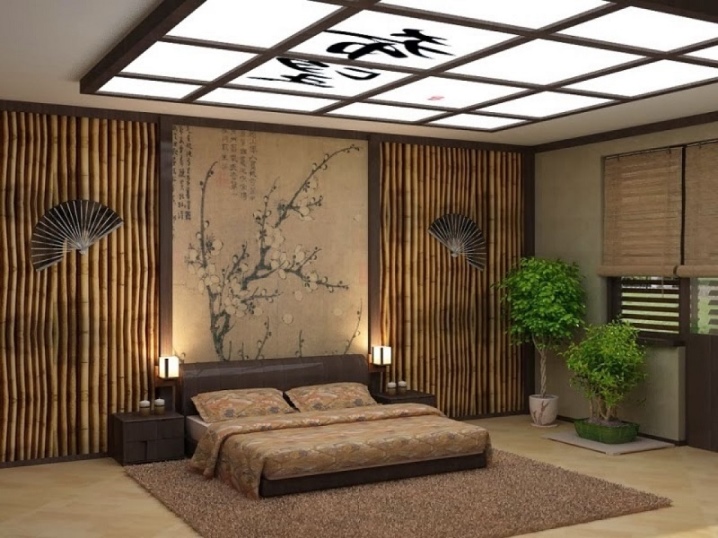
The kitchen is decorated in traditional black and white colors with the addition of red, which is important for Japan. All equipment is hidden in functional niches - it is not customary to flaunt it, this is not a decoration. The wall above the table is decorated with a traditional oriental pattern.
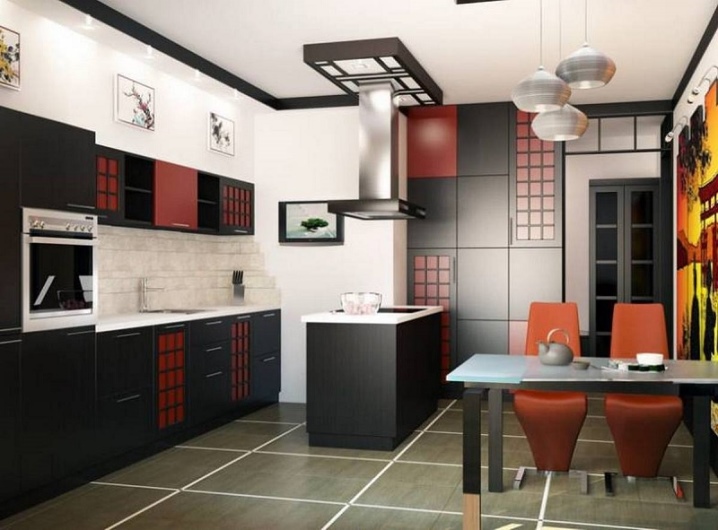
You can find out what a wabi-sabi interior is from the video below.













The comment was sent successfully.